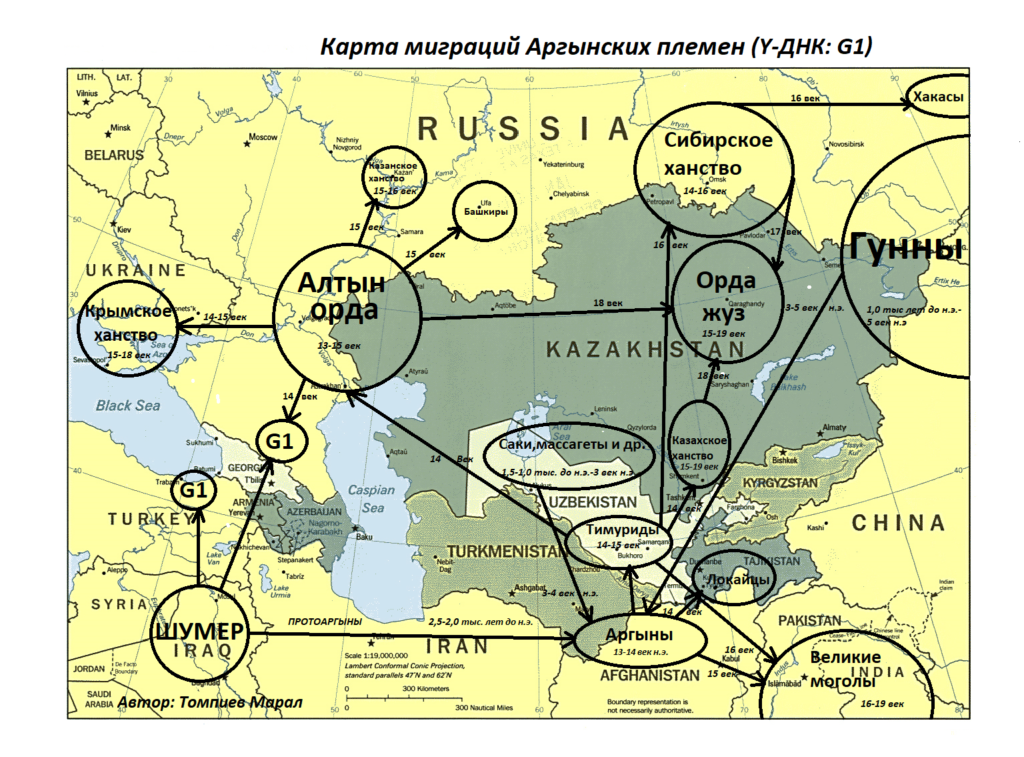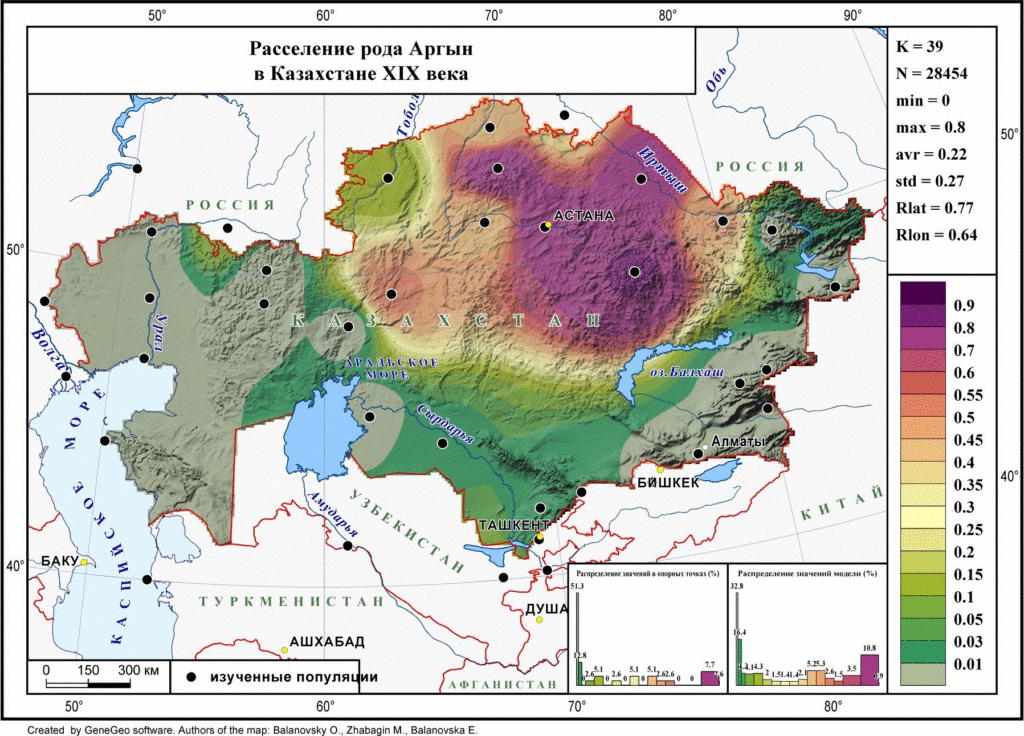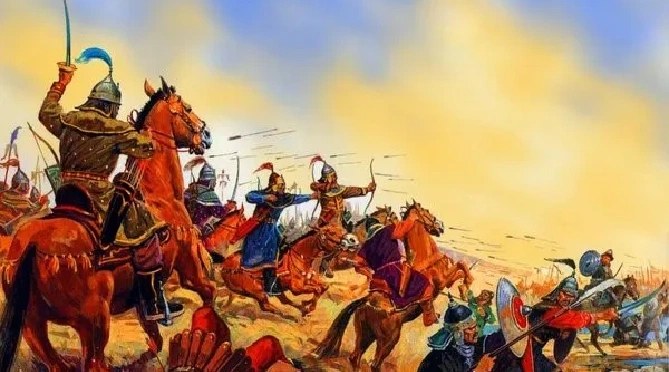The processes of ethnogenesis of the Kazakhs are an extensive and complex topic, replete with «white spots». Therefore, any new information about facts previously unknown to the general public is of great interest. Writer, historian, Turkologist, traveler Maral Tompiev is preparing for publication a book in which he will share his theory about the origin of one of the most numerous tribal associations of Kazakhs — Argyns. According to the author, their ancient ancestors were directly related to the Sumerian and proto-Iranian civilizational branches, which means that they outwardly differed radically from modern Argyns.
The DNA analysis that shocked
The problem of the origin of Argyns has long been of burning interest, and not only among historians. This was largely due to the fact that their appearance on the historical scene, unlike other Kazakh tribes, was sudden and late. They began to appear actively in various sources only in the 14th and 15th centuries. The most famous concept of Argyn origin suggests their connection with the ancient Huns: «ar» — distant, «gyn» — phonetically modified from «Hun».
In search of the historical truth about the origin of the Argyns, Maral Tompiev decided to go from several sides at once – he studied primary sources, toponyms, ethnonyms, linguistics, oral and written mythology, analyzed climate changes, conducted field research, and analyzed the DNA and racogenesis of contemporaries, including in Transcaucasia, Turkey, Iran and Afghanistan.
The origin story of the Argyns is interesting because it is one of the largest tribes that has been more or less known since the 11th century, when Mahmud Kashgari first described the Argu tribe in the western Pamirs (a possible part of his modern descendants is the Kyrgyz Orgu tribe). Where the Argyns came from, what they did, what was the territory of their settlement, into which tribes and clans they were divided – there is no information on this matter. Perhaps there were some primary sources, but they most likely burned down during the fierce resistance to the Mongols in the cities of the Amu Darya basin, in Balkh, Herat and other urban centers of that era.
Anyway, a few centuries later, the Argyns became the backbone of resistance to the Dzungars and were directly related to the formation of both the Kazakh Khanate and the territory of modern Kazakhstan. Therefore, the question naturally arises: «Where did they come from?». There was a lot of debate about this, but everyone agreed that they had a Hunnic, and then Mongolian, that is, Eastern, origin.
My interest in this topic was dictated, among other things, by personal motives. My father Kazken Kalievich Tompiev, a famous writer, began to study the history of Argyns, and he also tended to the Hunnic version of their origin. Relatively recently, when such a science as DNA genealogy came into the field of historical research, I turned to many Kazakhs-Argyns with a request to take DNA tests. It was possible to collect about 5,000 analyses, and according to their results it turned out that about 80 percent are carriers of haplogroup G1a (L1323).
Argyns are the only Kazakhs with such a haplogroup. I didn’t believe it at first and collected tests from 500 more people. And again I saw the same 80 percent (Sumerian cluster-G1). Well, where can you go, these are statistics.
The question arises: «How can this be?» The fact is that the ancestral homeland of haplogroup G1 is the Southern Caspian, Northern Iran, with a frequency of 10-20% found among the Turks and Persians of Khorosan, northern Pashtuns, 10-12% among Ashkenazi Jews, 35% (GG266) The Muslims of the Armenians are Khemshils and especially often, up to 90%, the Ossetians are Digorians. I went to Iran specifically for this: the Southern Caspian Sea and Khorosan province, where I took saliva samples from people living there in mountainous areas.
Dead ends of toponymy
After that, I began to study toponyms. Comparative analysis has shown that in the western part of the Great Steppe there are several times more toponyms with the root word «argo», «arg», «argu» than in the eastern part. For example, there are the Argun, Argudan, Sharo Argun rivers and the Argun gorge, the fortresses and settlements of Arguani, Argun, Argany, Argudan. There are also ethnonyms of the Georgian Argveli tribe, the Chechen teip (genus) Argun-oi in the Caucasus, the province and city of Gorgan (Organ) in the south of the Caspian Sea, and others. By the way, it is in the places associated with the name «argun» that haplogroups G1 and G2 are common.
Naturally, I had my doubts again. I think, well, it can’t be like that! Has everyone been wrong before me? Or am I wrong? I decided to go to Mongolia, got to the Gobi, where the Altai Ridge intersects with the Tien Shan, from where, in fact, all the Huns originated. There I was looking for tamga argynov: everywhere I showed a sign in the form of two circles and asked: But it turned out that no one had encountered such a designation. There is no ethnonym argun, no tamga with two circles and no other traces. I drove from Bayan-Ulgey to the Argun River, the right tributary of the Amur. This is a mispronunciation of the name Ergun (from Mongolian Wide River), in Chinese — with the same meaning Ergun He. Well, there’s nothing! And this cannot be, if we remember that, for example, the Naimans came from Mongolia. There are also traces of Jalairs, Konyrats, Kereits, and Uaks, but there are no Argyns. They were not in the troops of Genghis Khan, and later his descendant Sheibani Khan, during the conquest of Transoxiana.
This proves once again that they are not of Oriental origin, like the Naimans, Jalairs and Kereys. If they had been there, then such a large tribe, along with tamga, would have left other traces. In the Mongol empire, as well as in the Desht-i-Kipchak tribes in the 15th century, who came to Central Asia, they did not exist, they did not fight with them, they did not dock. So, it can be assumed that they lived to the south.
The fact that the Arguns lived in the independent state of Argun in Sindh and Baluchistan, as well as the support of Babur by Hakim of Kandahar Zun-n-Nur Argun, is described in the famous work of Babur-nam: part of the Arguns went with him on a campaign to conquer India. In the same regions where modern Lokai (Meiram) people live, part of the Argyns came to help Abu Said, Temirlan’s great-grandson, conquer the throne and recreate his empire. For this, he appointed 30 representatives of the Argyns as hakims of the cities of the empire, and one of them, Shikhim-biy, became a kushchi (a particularly close person to the khan, responsible for hunting with hunting birds). In another part of the vast steppe space, in the Crimea, the beys of the Argyns there were very influential figures, and the most famous of them was Tugai Bey.
These are some well-known historical facts.
Proto-Iranian roots?
Poet Olzhas Suleimenov followed the famous and authoritative researchers of Turkic history M.Tynyshpaev, A.Aristov and L.Gumilev supported the theory of the eastern origin of the Argyns. He found many root words in Sumerian and Kazakh, but at that time it was not possible to conduct DNA testing. Nevertheless, Olzhas Suleimenov suggested that about 9,000 years ago the Proto-Turks went to Sumer. All the primary sources prove that the Huns-Huns (Proto-Turks) appeared on the historical scene in the third century BC in northern China, then, in the fourth-fifth century, they found themselves in Europe, giving rise to the Great Migration of peoples from East to West.
The Huns, the largest nomadic Mongoloids, came in two streams. When they joined the Aryan tribes (R1a, R1b) and reached Europe, their Mongoloid character gradually decreased to 20-30 percent. The second, southern, stream reached the Amu Darya basin, conquered all the local tribes there, and the Ar-Huns (white or noble Huns) — the Ephthalite state — arose on this base. The ratio of Huns to the local population, as well as later conquerors-nomads of the Seljuk Turks and Mongols in China, was a maximum of 1 to 5 or 1 to 10, similar to the ratio of eastern haplogroups to Sumerian — G1 among the Kazakh Argyns. The descendants of the Sumerians from Mesopotamia, who created a powerful urban civilization there, and the Persians mixed with the Huns. The latter, as conquerors, introduced the Proto-Hunnic language with a large sprinkling of Sumerian and Persian words and left the cult of horse breeding. Moreover, Balkhash was called Argun Lake. The Persians called them Basmals (a crossbreed) – this is the tribe that defeated the second Turkic khaganate. The Yuezhi Chinese described them as light–colored Caucasians, blond with long noses and a thick beard.

The map is presented by M.Tompiev
According to my assumptions, it could not be that there were no Argyn roots left in their ancestral homeland, in the Amu Darya basin. The clue came as always unexpectedly — this is the Uzbek tribe of the Lokai, whose number is now almost equal to the Argyns — more than 2 million (according to the data provided by M.Tynyshpaev, in 1917 the number of Argyns was 890 thousand). They live in the very south of the Turkic world, only the Pashtuns are south of them. Unlike sedentary Uzbeks, the Lokai lead a nomadic lifestyle and raise horses. And they also «bite» when pronouncing. And there, among the 12 names of the tribes, there were six that coincide with the Argyn ethnonyms. The tribal shezhire of the Lokai people with a division into four (five) meirams almost completely coincides with the Argyn one. This gives an answer to the question: where did the bright Kazakhs come from, especially in Sary-Arka? Up to 40 percent of the Lokai are light. They have mainly a Pontic racial type (dominated by the Sumerians and the northern highlanders of Iran) with a Mongoloid admixture. Before mixing with the Dzungars, especially in the female line in the 18th and 19th centuries, Argyn racial type was probably the same as that of the Lokai.

The natural and climatic factor and the zigzags of ethnogenesis
When analyzing ethnopolitical processes, the natural and climatic factor is not always taken into account, and yet it is very important. In the Middle Ages, the climate was much more humid, the level of Lake Balkhash was 8-10 meters higher, and its area is twice as large as it is now, it was not divided into salty and fresh parts. And geographical zones throughout Eurasia, including the forest-steppe zone, were located 200-250 km south of the modern value. The boundaries of the settlement of nomads were connected with the geography of the settlement of numerous herds of horses. The northern boundary of the settlement of the Turks of Central Asia began from the edge of the taiga, including the forest-steppe belt. The southern border reached the northern slopes of the Hindu Kush and the western Pamirs. On the territory of Kazakhstan in the 13th century, the steppe space from the mountains of the southern Urals and Mugodzhar, including the mountainous parts of northern Ulytau and Sary-Arka to Tarbagatai and Altai, was a continuous forest-steppe, the remnants of which were preserved in the oases of the Kokshetau, Bayanaul, Kentau, Karkaraly, Kyzyltas and Kyzylarai mountains.
For centuries, ancient Sumerians and Persians, Saks and Massagets from the Aral Sea, Yuezhi, Huns, Ephthalites, Basmals and Turks from Altai found refuge on the edge of the southern border of the settlement of equestrian nomads in the mountain gorges of the Hindu Kush, who, having gone through complex genetic processes, united in a union of tribes — under the common name Argyns. The name Argun (Ergun) is of Turkic origin and means «noble or brave Hun». Those tribes of Aryans, Saks, who settled on the southern slopes of the Hindu Kush, unsuitable for horse breeding, preserved their ancient language and culture, later began to call themselves Gurts and Pashtuns.
The Northern Hindu Kush (in Turkic and Kazakh mythology, Kyndyk kosh, Baysun), a fertile region in the southern part of the Amu Darya basin, is the ancestral homeland of the Argyns, who became known as warriors who supported the famous Argun Khan, grandson of Khagan Hulagu, in the struggle for power after the formation of his ulus or horde on the territory of northern Khorasan in the late 13th century.of the 20th century. During that turbulent period of feudal fragmentation of the Genghis Khan Empire, many Turkic and Mongolian tribal unions were formed by the names of the leaders or military leaders of their uluses, and not necessarily the Genghisids. Nogais, Lokais, non-Kuderians, Uzbeks, from the Jagatai ulus — Jagatais, even the Jagatai language. The collective name Argyn, which turned into an ethnonym, began to be called the union of various nomadic tribes that mixed with each other — the Saks, Aryans, Massagets, Gilzais, Ephthalites, Tokhars, Huns, Turks and others who settled in the Amu Darya basin in the northern foothills of the Hindu Kush. The Lokai (Lokai – translated as «nimble» military commander of the ulus) They settled in the area of the Gissara Mountains (Kensai) north of the Amu Darya, Nikudertsy (Nikuder is the leader of the ulus he created) They lived south-east of Argunsky ulus.
At the place of long-term residence of the Argyns in the valleys of the Hindu Kush, toponyms remained — the Argyn Doba river and valley and the Argyndeval settlement in Kabul (when it was conquered by our ancestors), the Gorgan Mountains (Orgyn) in Khorasan. The ethnonym «argun», «argyn» also spread to all tribes of different origin and predominantly Caucasian type that lived on the territory of Argunsky ulus. Among the neighboring peoples, it took on the shade of mixed tribes that absorbed the blood of the Sumerians, Aryans, Saks and Massagets with the Huns and Turks. Therefore, haplogroup G in the northern Hindu Kush is very common among local Pashtuns (Gilzai) and local Turks.
The Argyns, like their nomadic ancestors, specialized in horse breeding, the Lokai even bred a new breed of mountain horses, famous all over the world. Like all Turks, Argyns drove herds to mountain pastures — dzhailau in summer, and in winter settled in warm lowlands – kystau, located in river valleys and plateaus, roaming between cities, fields, villages and villages of farmers, merchants and artisans. South-east of Argynsky ulus was Nikudersky, consisting of nomadic Turkic and Pashtun tribes, among whom there were many Naimans. In the 15th century, the Nicuderians and Argyns supported Babur and, having captured Kabul, and then India, created the Mughal state. The nomadic Argyns retained the Turkic language and their name, some split off, went south with the Nikuderians and «emptied out» (Abdals, Gilzai, Turani, or Durani, the ruling dynasty), some became part of the Mughals and the Lokai. The Nicuderians as a separate tribe became part of the Mughals, Hazaras and Pashtuns.
And two more strokes. A hundred kilometers south of Kabul is Argandival — Argyn village, and Argyn Karachi Bay, who served as the Mughal vizier, founded the port of Karachi in Pakistan.
In the Kazakh steppe, the first mentions of Argyns (zhety momyn: atygai, guard) go together with Kuchum Khan, the founder of the Siberian Khanate. The main part of the Argyns (bes meiram) moved to Sary-Arka from the foothills of Karatau, which used to be called Argyntau. According to legend, this happened after kanzhygaly Bogenbai-batyr told the famous Kazybek-bi that there were wonderful pastures for horses. It should be clarified here that horse breeders in the Middle Ages were considered the wealthiest people.
What geneticists say
In 2015, Russian and Kazakh geneticists conducted a detailed study of the Y-chromosomal haplogroup G1, measuring the degree of mutation and identifying migration directions. The results were published in the journal PLoS ONE. Scientists have reconstructed the phylogenetic tree of this haplogroup. Five branches stood out on it, three of which are large: the Kazakh, peculiar to a specific Kazakh family — Argyns, as well as the Armenian and Bashkir (Argyn family). The phylogenetic tree absolutely exactly coincided with the Kazakh family tree.According to geneticists, the Armenian and Bashkir branches descend from a common ancestor, and the Kazakh is an independent line. According to the researchers, the distribution area of G1 correlates well with the area of ancient Sumerian and Iranian-speaking groups that lived both in the mountains of Iran and in the Eurasian steppes. «Haplogroup G1 probably remained a rare genetic component among many Eurasian and especially Iranian-speaking populations. Its frequency is slightly higher in the supposed ancestral homeland – in Iran and Armenia. When proto–Iranian languages in the steppes were replaced by Turkic ones (probably in the middle of the first millennium AD), the speakers of haplogroup G1 were most likely assimilated into Turkic and then into Mongolian populations,» the authors of the study write.

It is proved that their common ancestor, known from historical sources and legends, is actually the biological ancestor for most modern male Argyns. Most likely, it was the legendary Meiram Sopa (Muslim Sufi), who lived 600 years ago (in the 14th century).
Meiram Sopa, Karakhoja and other ancestors of the Argyns were not just Muslims, but Sufis, which means they lived in the center of Turkic Islam — in the Amu Darya basin, which denies their eastern origin from the valley of the Ergyun River (Argun) from distant Manchuria. Since there has never been any Islam, much less the institution of Khojas and Sufis.
In the above-mentioned work, the researchers revealed a coincidence of genetic and genealogical data (the number of descendants from the first ancestor according to shezhira), which fully confirm the theory put forward by Maral Tompiev. The reader can find out more about the origin of the Argyns in his new book «The Era of Finding Borders».
